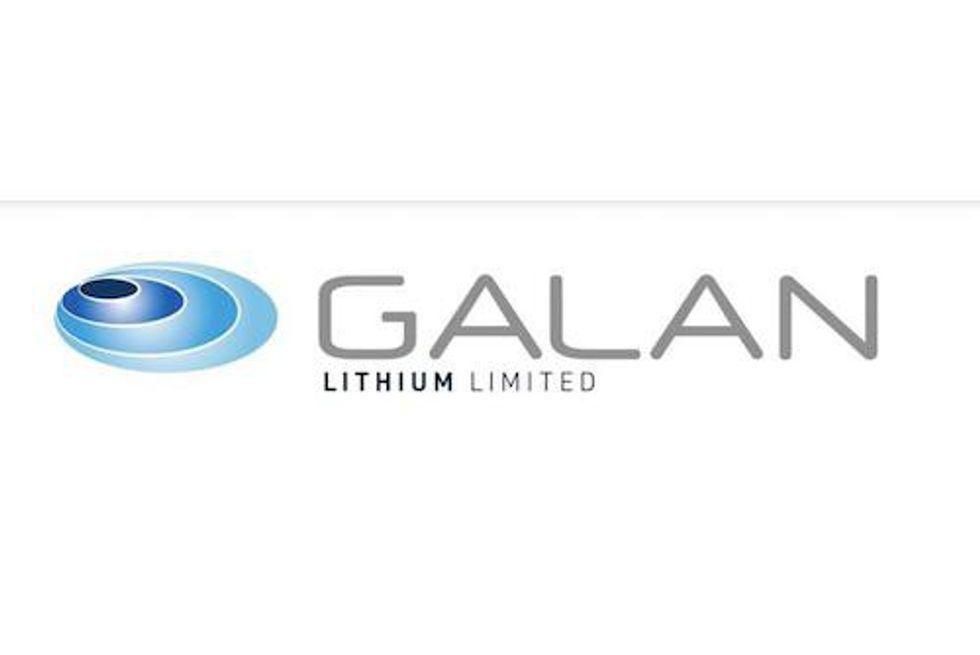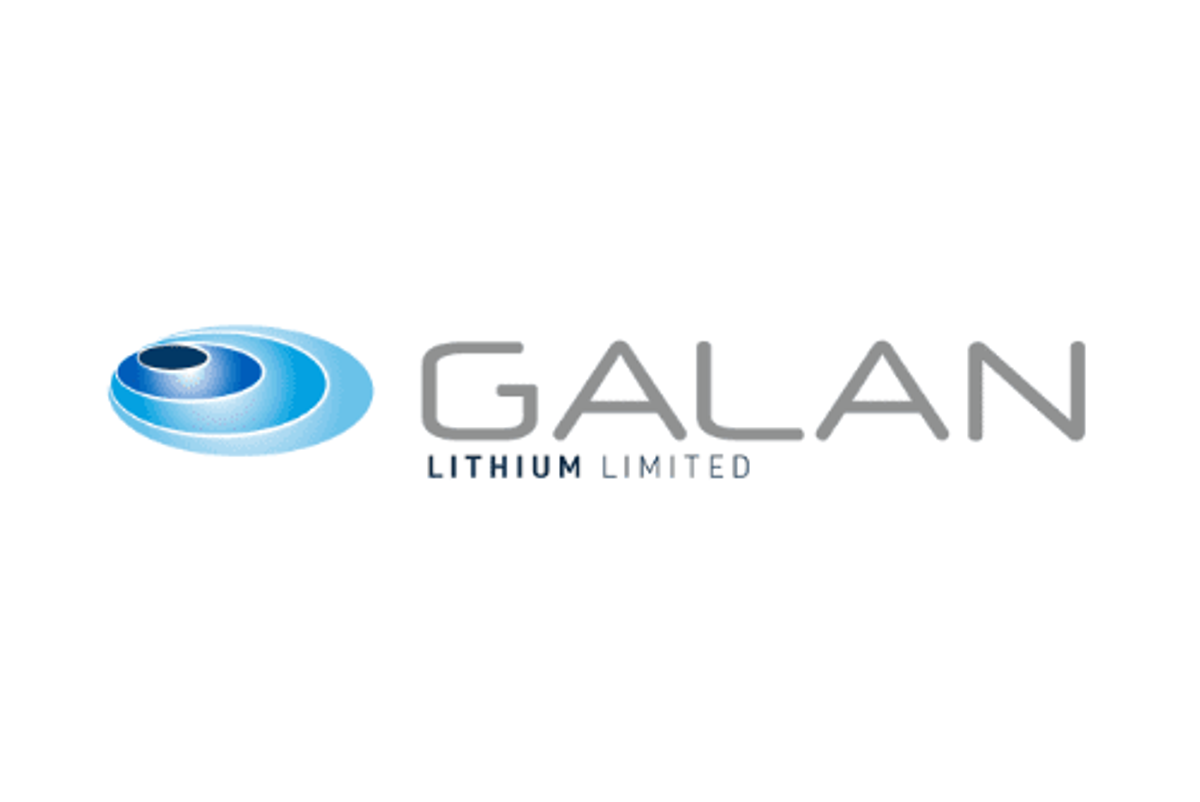
- WORLD EDITIONAustraliaNorth AmericaWorld
Investing News NetworkYour trusted source for investing success
May 17, 2021
Highlights:
- Galan to commence foundation works for Hombre Muerto West (HMW) project to accelerate commencement of Feasibility Studies
- SRK Consulting (Australia) to commence resource to reserves work
- WPS Group (their team includes ex SQM hydrogeologist) appointed to support hydrogeological model at HMW
- Ad-Infinitum preparation work has commenced on the Feasibility Study for the design of the lithium carbonate plant and a revised design of the evaporation ponds system
- Commencement of aerial topography survey and design early works imminent
- Greenbushes South JV field work commenced
Galan Lithium Limited (ASX: GLN) (Galan or the Company) is pleased to announce that it has commenced early foundation works for its feasibility study at its flagship Hombre Muerto West (HMW) project located in the South American Lithium Triangle in Catamarca, Argentina. It has also kicked off fieldwork associated with the Greenbushes South JV (GLN 80%- LIT 20%).
Galan’s Managing Director Juan Pablo (JP) Vargas de la Vega said: “It is all hands-on deck for the essential preparation of further geological data required to perform the Feasibility Studies for the Hombre Muerto West Project. Our commitment remains focused on getting HMW online as soon as possible. The work being undertaken by our consulting team of specialists will further strengthen the project by optimising our methods and increasing the confidence in our results to date.
Initial geological fieldwork has also commenced at the Greenbushes South JV project. I am currently on the ground supporting Galan’s team over the next week or so to expedite the field exploration work.”
Resource to Reserves
The Company has recently appointed WSP Consulting Chile (WSP) and SRK Consulting (Australia) Pty Ltd (SRK) in respect of transforming the huge HMW resource into reserves, the main foundation for its feasibility study.
WSP will provide support and design work, including production wells, for different aspects related to the hydrogeology of the HMW tenements located in the Hombre Muerto Salar Basin. WSP’s team includes two former SQM employees who have a long history working with lithium brines.
SRK, in association with WSP, will review the current resource estimate and then undertake reserve conversion work for the HMW project.
Drilling at HMW fill follow up soon after the design and location of the well is confirmed. Galan is in advanced discussion with drilling companies to execute the programme.
Other Works
The following early works items have started or are due to start:
- Aerial survey to supply the topography data required at Feasibility Study level quality;
- Design of the mass balance for the brine concentrate with 6% of Li plus design of the pilot plant;
- Process design and mass balance of lithium plant for 6% of Li but also considering a lower Li content for selecting the optimum lithium plant design; and
- Upgrade the design of the pond system for up to 25.000 tpa of LCE with potential production including two stages, to be assessed
Preparation works for the FS have already commenced with the engagement of Ad-Infinitum for creating the design of the pilot plant and a specialised topography and ponds designing consultants for the preparation of a revised design of the evaporation ponds system, which should include the most favourable terrain at Rana de Sal and Del Condor mining tenements.
In parallel, discussions with engineering firms for the resolution of the final engineering assignment of the FS have been conducted and are well advanced.
Greenbushes South JV
Work at the Greenbushes South JV had commenced. The Galan team has been granted initial private access to parts of the relevant geological areas of interest to proceed with field work that includes soil and rock chip sampling as well as mapping. Desktop geological work is also planned in the near future on the recently granted E70/4777 tenement ~25km north of the Greenbushes mine. Another JV tenement, E70/5680, was also recently granted.
The Greenbushes South JV is an unincorporated joint venture between Galan and Lithium Australia NL (ASX:LIT).
The Galan Board has authorised this release.
For further information contact:
Juan Pablo (“JP”) Vargas de la Vega Terry Gardiner
Managing Director Non-Executive Director
Email: jp@galanlithium.com.au Email: TGardiner@galanlithium.com.au
Tel: +61 8 9322 6283 Tel: + 61 400900377
About Galan
Galan is an ASX listed company exploring for lithium brines within South America’s Lithium Triangle on the Hombre Muerto salar in Argentina. Hombre Muerto is proven to host the highest grade and lowest impurity levels within Argentina and is home to Livent Corporation’s El Fenix operation and Galaxy Resources and POSCO’s Sal de Vida projects.
Galan has three projects:
Candelas: a ~15km long by 3-5km wide valley filled channel which project geophysics and drilling have indicated the potential to host a substantial volume of brine and over which a maiden resource estimated 685kt LCE (Oct 2019). Furthermore, Candelas has the potential to provide a substantial amount of processing water by treating its low-grade brines with reverse osmosis, this is without using surface river water from Los Patos River.
Hombre Muerto West (HMW): a ~14km by 1-5km region on the west coast of Hombre Muerto salar neighbouring Livent Corp to the east. HMW is currently comprised of seven concessions – Pata Pila, Rana de Sal, Deceo III, Del Condor, Pucara, Catalina and Santa Barbara. Geophysics and drilling at HMW demonstrated a significant potential of a deep basin. In March 2020, a maiden resource estimate delivered 1.1Mt of LCE for two of the largest concessions (Pata Pila and Rana de Sal). That resource now sits at 2.3Mt of LCE with exploration upside remaining for the rest of the HMW concessions not included in the current indicated resource.
Greenbushes South Lithium Project: Galan has an Exploration Licence application (E70/4629) covering a total area of approximately 43 km2. It is approximately 15kms to the south of the Greenbushes mine. In January 2021, Galan entered into a sale and joint venture with Lithium Australia NL (ASX:LIT) for an 80% interest in the Greenbushes South Lithium project, which is located 200 km south of Perth, the capital of Western Australia. With an area of 353 km2, the project was originally acquired by Lithium Australia NL due to its proximity to the Greenbushes Lithium Mine (‘Greenbushes’), given that the project covers the southern strike projection of the geological structure that hosts Greenbushes. The project area commences about 3km south of the current Greenbushes open pit mining operations.
The Conversation (0)
20 April
Galan Lithium
Investor Insight
Galan Lithium’s investment appeal is driven by its Hombre Muerto West project, a top 20 global lithium resource featuring high-grade, low-cost lithium brine concentrate, on track for near-term production in Argentina’s renowned mining region.
Overview
Argentina is no stranger to lithium mining. The South American nation is one of three encompassed in the prolific Lithium Triangle, a region that holds more than 60 percent of the world’s lithium resources. Argentina has the world’s second greatest endowment of lithium reserves (17 Mt), concentrating lithium operations in the provinces of Jujuy, Salta and Catamarca.
Demand for lithium is forecasted to grow from approximately 1 Mt LCE in 2024 to around 3Mt in 2030, a compound annual growth rate of around 20 percent. Argentina has committed to $7 billion worth of investment for lithium production with strong growth projected for exports at $1.1 billion in 2023.
Galan Lithium (ASX:GLN,FSX:9CH) is an Australia-based international mining development company focused on its high-quality lithium brine projects in Argentina – Hombre Muerto West and Candelas. The company also holds a highly prospective lithium project in Australia – Greenbushes South.
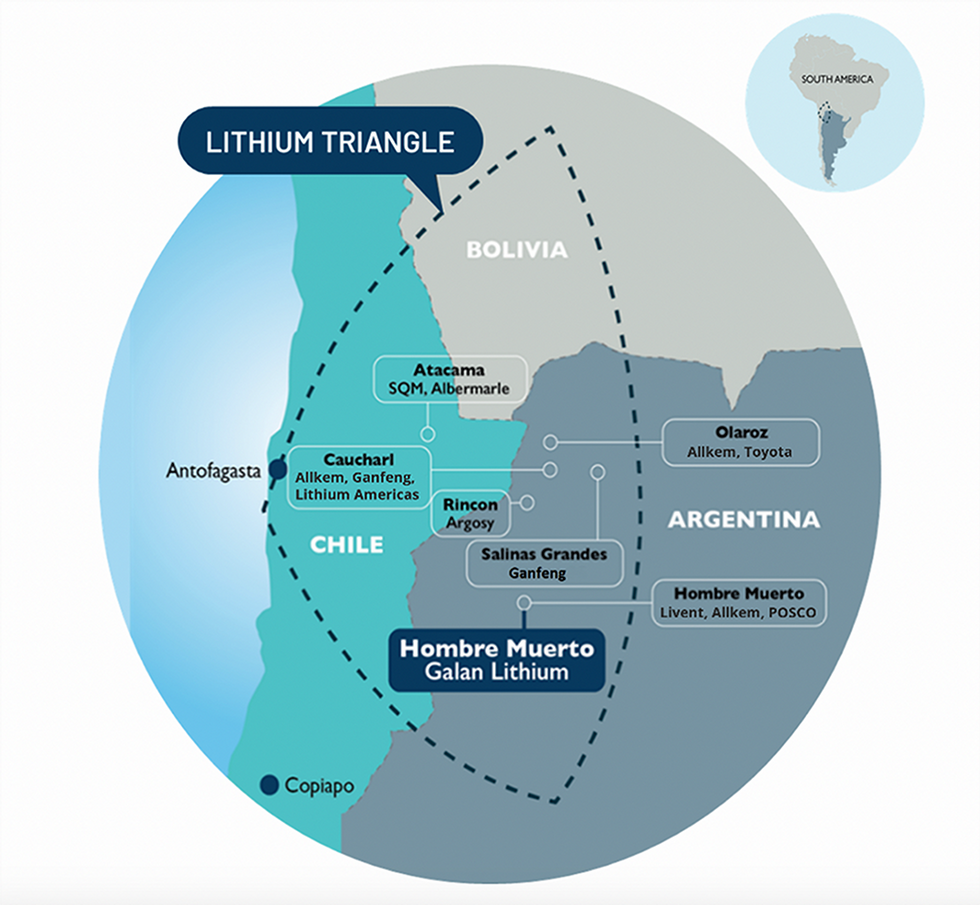
The company’s flagship Hombre Muerto West (HMW) project hosts some of Argentina’s highest grade and lowest impurity levels with an inventory of 8.6 million tons (Mt) contained LCE @ 859 mg/L lithium, with 4.7 Mt contained LCE @ 866 mg/L Li in the measured category. The 100-percent-owned property is strategically located near Rio Tinto’s recently acquired Arcadium Lithium project, highlighting its position within a highly sought-after lithium region
Galan has signed a commercial agreement with the Catamarca Government supporting the grant of permits to enable the commercialisation of lithium chloride concentrate from HMW to be sold locally or exported internationally.
In August 2024, Galan entered into a memorandum of understanding with Chengdu Chemphys Chemical Industry Co. for an offtake prepayment agreement for the HMW project. Once a definitive agreement is executed, Chemphys will purchase a total of 23,000 tonnes lithium carbonate equivalent, as a lithium chloride product, over the first five years of production from Phase 1 of the HMW project. Chemphys will also provide Galan with an offtake prepayment facility to facilitate the continued development of Phase 1 of the HMW project.
The company also executed binding agreements with Authium Limited, securing a comprehensive funding and offtake package to support initial production from the Hombre Muerto West (HMW) Project. Under the agreements, Authium will fund, supply, and operate processing technology at HMW, significantly reducing Galan’s upfront capital and operating costs.
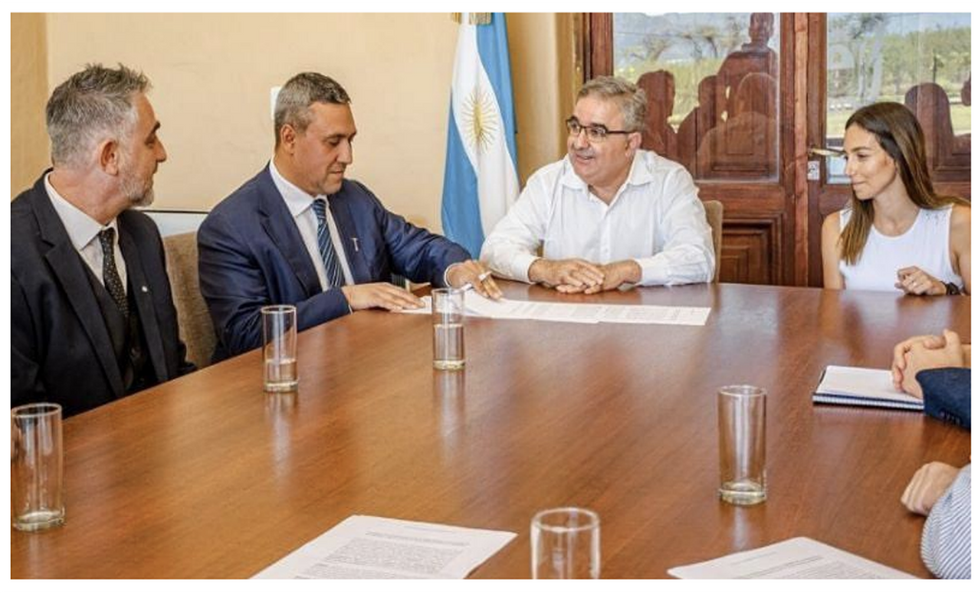
Catamarca Governor Raúl Jalil and Galan Lithium Managing Director Juan Pablo Vargas de la Vega in Catamarca.
In September 2024, Galan successfully completed a capital raising of AU$20 million, including a fully-subscribed Entitlement Offer of $13.3m, reflecting strong shareholder support and confidence in the Company’s strategic direction and the development of its HMW project
In addition to Hombre Muerto West, Galan Lithium’s portfolio includes several strategically positioned projects that complement its flagship asset:
- Candelas Project (Argentina): Located within the Hombre Muerto Basin, this underexplored project boasts a maiden resource estimate of 685kt LCE and is incorporated into Galan’s Phase 4 expansion plans targeting 60ktpa LCE production by 2030.
- Greenbushes South Project (Australia): Situated just 3 kilometres south of the world-class Greenbushes lithium mine, this project offers strong exploration potential for lithium-bearing pegmatites. Galan is progressing land access agreements and holds an exploration license through to 2029.
- James Bay & Ontario Projects (Canada): In 2023, Galan acquired property blocks in Quebec and Ontario located in globally recognized lithium provinces, providing further exploration upside in key jurisdictions.
Backed by a highly experienced management team, Galan is well-positioned to advance these complementary projects while maintaining its primary focus on developing HMW into a world-class lithium production hub.
Company Highlights
- Galan Lithium is an ASX-listed company developing lithium brine projects within South America’s lithium triangle on the Hombre Muerto salar in Argentina.
- The company has two high-quality projects in the works: its flagship Hombre Muerto West (HMW) and the Candelas lithium project, both in Argentina. The two projects combined bring the company’s current total mineral resource estimate to 8.6 million tons lithium carbonate equivalent @ 859 mg/L lithium.
- HMW leverages advantageous positioning near Arcadium Lithium’s project, which is subject to an acquisition by Rio Tinto, highlighting the strategic importance of this high-grade lithium region
- Galan’s lithium Resources are ranked among the top 20 in the world
- HMW sits in the lowest quartile of the global lithium cost curve, leveraging brine extraction advantages for cost efficiency
- High-grade, low-impurity brine concentrate validated by robust offtake interest and market alignment
- Galan’s phased approach and strong stakeholder collaboration mitigate risks and ensure steady progress toward first production in 2025
- The HMW Phase 1 (5.4 ktpa LCE) execution plan is progressing well with the delivery of the first evaporation-ready pond expected in 2024, and production in H2 2025.
- The HMW Phase 2 definitive feasibility study (DFS) delivers compelling economics with 21 kilo-tons per annum (ktpa) lithium carbonate equivalent (LCE) operation at HMW, targeting a high-quality, 6 percent concentrated lithium chloride product (equivalent to 12.9 percent lithium oxide or 31.9 percent LCE) in 2026.
- Galan has signed a commercial agreement with the Catamarca Government enabling the commercialisation of lithium chloride concentrate from HMW to be sold locally or exported internationally.
- Galan is the first mining company to apply for the Argentine ‘RIGI’, an incentive regime for large scale investments
- Galan is transitioning into a major lithium project developer and remains committed to conducting fast-tracked lithium development in its prolific projects with a target production of 60 ktpa LCE from HMW and Candelas by 2030.
Key Projects
Hombre Muerto West Project
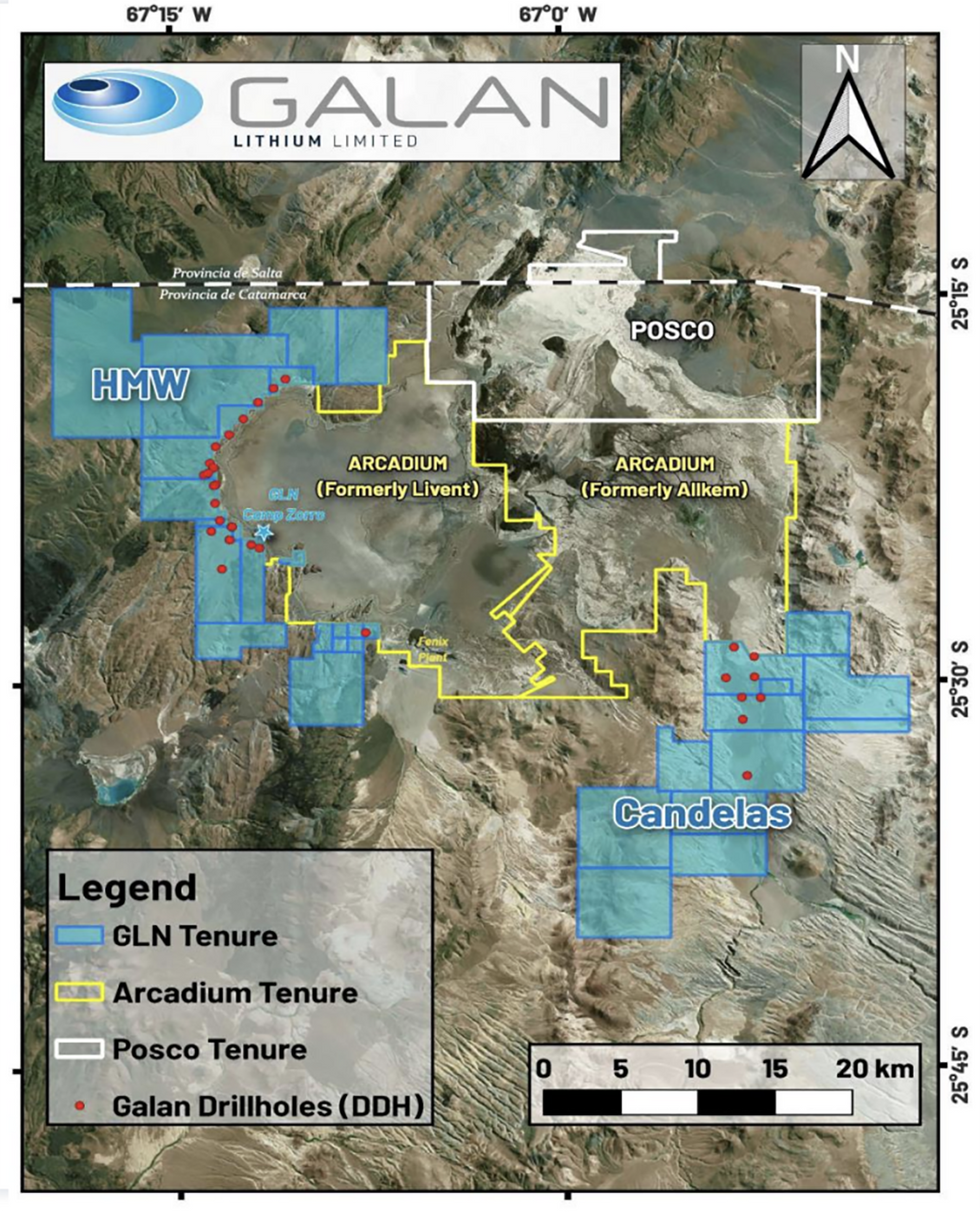
The 100-percent-owned Hombre Muerto West project is a large land property that sits on the west coast of the Hombre Muerto salar in Argentina, the second-best salar in the world for the production of lithium from brines. The property also leverages strategic positioning near Arcadium Lithium, recently acquired by Rio Tinto.
Galan has increased HMW’s mineral resource to 8.6 Mt contained LCE @ 859 mg/L lithium (previously 7.3 Mt LCE @852 mg/L lithium), one of the highest grade resource estimates declared in Argentina. HMW’s measured resource is now at 4.7 Mt contained LCE @ 866mg/L lithium. Inclusion of the Catalina tenure adds ~1.3 Mt LCE to the HMW resource.
The pilot plant at HMW has validated the production of lithium chlorine concentrate, adding reagents to eliminate impurities, and generating a concentrate at 6 percent lithium. The plant comprises pre-concentration ponds, a lime plant, a filter press and concentration ponds.
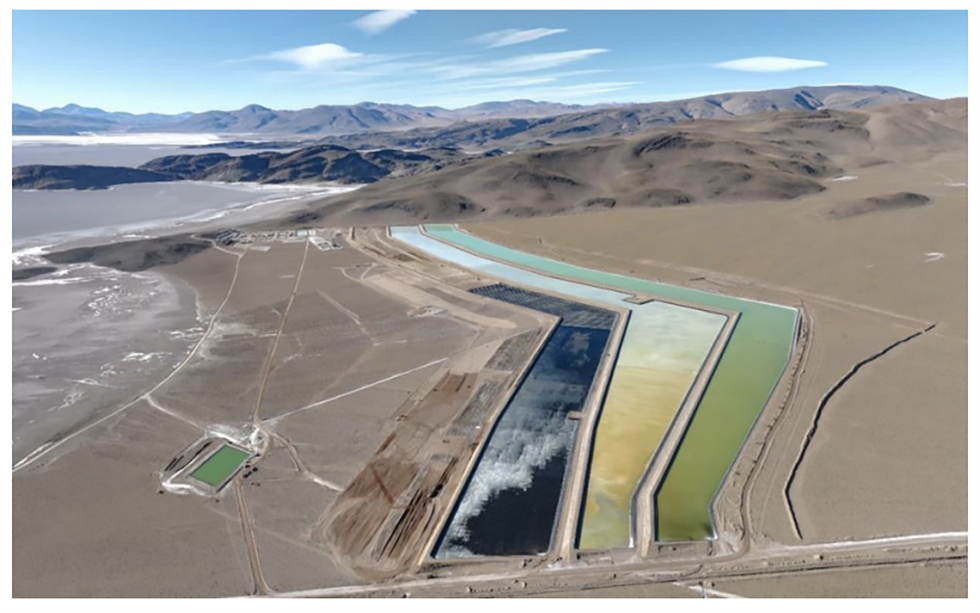
Pilot Plant at HMW
Construction for Phase I has already commenced for 5.4 ktpa LCE production at HMW, and aims to deliver lithium chloride production in H2 2025. The fourth long-term pumping test (PBRS-03-23) results at HMW record an outstanding lithium mean grade of 981 mg/L - the highest reported grade from a production well in the Hombre Muerto Salar.
In October 2024, Galan announced 45 percent project completion with pond construction at 76 percent and project execution is advancing as planned.
A definitive feasibility study (DFS) for phase 2 shows a 20.85 ktpa LCE operation at HMW, targeting high-quality, 6 percent concentrated lithium chloride product (equivalent to 12.9 percent lithium oxide or 31.9 percent LCE) in 2026. The DFS also indicated phase 2 will deliver a post-tax NPV (8 percent) of US$2 billion, IRR of 43 percent and free cash flow of US$236 million per year. Phase 2 provides an exceptional foundation for significant economic upside in phases 3 and 4, targeting 60 ktpa LCE production by 2030.
Galan has entered into a memorandum of understanding with Chengdu Chemphys Chemical Industry Co. for a prepayment offtake agreement. Once a definitive agreement is executed, Chemphys will purchase a total of 23,000 tonnes of lithium carbonate equivalent, as a lithium chloride product, over the first five years of production from Phase 1 of the HMW project.
Chemphys will also provide Galan with a US$40 million offtake prepayment facility to facilitate the continued development of the HMW project.
The company has also signed binding agreements with Authium Limited, establishing a comprehensive funding and offtake package to support initial production at the Hombre Muerto West (HMW) Project. As part of the agreement, Authium will fund, supply, and operate the processing technology at HMW, materially lowering Galan’s upfront capital requirements and ongoing operating costs.
Galan now has 100 percent full ownership of the Catalina tenement that borders the Catamarca and Salta Provinces in Argentina. The newly secured Catalina tenure has a strong potential to significantly add to the existing HMW resource. The tenure also covers the Catalina, Rana de Sal II, Rana de Sal III, Pucara del Salar, Deseo I and Deceo II tenements.
Greenbushes South Lithium Project
The 100-percent-owned Greenbushes South lithium project is located near Perth, Western Australia, and is three kilometers south of the world-class Greenbushes lithium mine, managed by Talison Lithium. The Greenbushes South tenements can be found along the Donnybrook-Bridgetown Shear Zone geologic structure, which hosts the lithium-bearing pegmatites at the Greenbushes Lithium Mine.
Greenbushes South covers nearly 315 square kilometers, and hosts elevated pathfinder elements with well-defined anomalies adjacent to the property.
Management Team
Richard Homsany - Non-executive Chairman
Richard Homsany is an experienced corporate lawyer and has extensive board and operational experience in the resources and energy sectors. He is the executive chairman of ASX-listed uranium exploration and development company Toro Energy Limited, executive vice-president of Australia of TSX-listed uranium exploration company Mega Uranium and the principal of Cardinals Lawyers and Consultants, a boutique corporate and energy and resources law firm. He is also the chairman of the Health Insurance Fund of Australia (HIF) and listed Redstone Resources and Central Iron Ore and is a non-executive director of Brookside Energy Homsany’s past career includes time working at the Minera Alumbrera Copper and Gold mine located in the Catamarca Province, northwest Argentina.
Juan Pablo (‘JP’) Vargas de la Vega - Founder and Managing Director
Juan Pablo Vargas de la Vega is a Chilean/Australian mineral industry professional with 20 years of broad experience in ASX mining companies, stockbroking and private equity firms. JP founded Galan in late 2017. He has been a specialist lithium analyst in Australia, has also operated a private copper business in Chile and worked for BHP, Rio Tinto and Codelco.
Daniel Jimenez - Non-executive Director
Daniel Jimenez is a civil and industrial engineer and has worked for a world leader in the lithium industry, Sociedad Química y Minera de Chile, for over 28 years. He was the vice-president of sales of lithium, iodine and industrial chemicals where he formulated the commercial strategy and marketing of SQM’s industrial products and was responsible for over US$900 million worth of estimated sales in 2018.
Terry Gardiner - Non-executive Director
Terry Gardiner has 25 years’ experience in capital markets, stockbroking and derivatives trading. Prior to that, he had many years of trading in equities and derivatives for his family accounts. He is currently a director of boutique stockbroking firm Barclay Wells, a non-executive director of Cazaly Resources, and non-executive chairman of Charger Metals NL. He also holds non-executive positions with other ASX-listed entities.
María Claudia Pohl Ibáñez - Non-executive Director
María Claudia Pohl Ibáñez is an industrial civil industrial engineer with extensive experience in the lithium production industry. Until recently, she worked for world leader in the lithium industry Sociedad Química y Minera de Chile (NYSE:SQM, Santiago Stock Exchange:SQM-A, SQM-B) for 23 years, based in Santiago, Chile. During her time at SQM, she held numerous senior leadership roles including overseeing lithium planning and studies. Ibáñez brings significant lithium project evaluation and operational experience whilst joining the board at a critical juncture in Galan’s journey to becoming a significant South American lithium producer. Since leaving SQM in late 2021, Ibáñez has been managing partner and general manager of Chile-based Ad-Infinitum, a process engineering consultancy, with a specific focus on lithium brine projects under study and development, and the associated project evaluations.
Ross Dinsdale - Chief Financial Officer
Ross Dinsdale has 18 years of extensive experience across capital markets, equity research, investment banking and executive roles in the natural resources sector. He has held positions with Goldman Sachs, Azure Capital and more recently he acted as CFO for Mallee Resources. He is a CFA charter holder, has a Bachelor of Commerce and holds a Graduate Diploma in Applied Finance.
Keep reading...Show less
Developing high-grade lithium brine projects in Argentina
18h
Top 5 Australian Mining Stocks This Week: Argosy Climbs 89 Percent on Rincon Lithium Spot Contract
Welcome to the Investing News Network's weekly round-up of Australia’s top-performing mining stocks on the ASX, starting with news in Australia's resource sector.
This week's top performing stocks includes firms focused on a wide variety of metals, including lithium, rutile and manganese. Lithium stocks, including top gainer Argosy Minerals (ASX:AGY), picked up momentum this week as prices moved upwards for a second straight week.
Companies focused on magnetite and rare earths were also among the week's top performers, including Freehill Mining (ASX:FHS), which saw its shares surge following insider buying from key executives including Chairman Benjamin Jarvis.
The top stocks below weren't the only ASX companies making news this week. Gold company Meeka Metals (ASX:MEK) joined the spotlight by announcing its first gold pour at the Murchison gold project in Western Australia, which was achieved within 12 months of breaking ground.
Additionally, Cobalt Blue Holdings' (ASX:COB) Broken Hill cobalt project was awarded a three-year extension to its major project status initially granted in March 2022.
Mining giant Rio Tinto (ASX:RIO,NYSE:RIO,LSE:RIO) is moving to the next stage of mine development at its Brockman Syncline 1 iron ore project in Pilbara, Western Australia. The company has already committed a US$1.8 billion investment to extend the life of the Brockman hub, with first ore expected in 2027.
Market and commodity price round-up
The S&P/ASX 200 index opened at 8,514.20 on Monday (June 30) and closed at 8,600.70 on Thursday (July 3), reflecting a 1 percent gain over the period.
As for precious metals, gold climbed by 1.93 percent in US dollars, starting the week at US$3,274.11 per ounce and closing at US$3,337.32 by July 4. In Australian dollars, gold increased 1.58 percent from AU$5,013.87 to AU$5,093.25.
Silver jumped 2.61 percent in US dollars this week, opening at US$36.00 on Monday and closing the week at US$36.94. The metal also climbed in Australian dollars, up 2.25 percent from AU$55.13 to AU$56.37 within the same period.
Top ASX mining stocks this week
How did ASX mining stocks perform against this backdrop?
Take a look at this week’s five best-performing Australian mining stocks below as we break down their operations and why these mining stocks are up this week.
Stock data for this article was retrieved at 4 p.m. AEST on July 3 using TradingView's stock screener. Only companies trading on the ASX with market capitalizations greater than AU$10 million are included. Mineral companies within the non-energy minerals, energy minerals, process industry and producer manufacturing sectors were considered.
1. Argosy Minerals (ASX:AGY)
Weekly gain: 88.89 percent
Market cap: AU$27.66 million
Share price: AU$0.034
Argosy Minerals is a Perth-based lithium producer established in 2010. The company’s flagship asset is the Rincon lithium brine project in Argentina’s Salta Province, in which it currently holds a 77.5 percent interest with plans to increase its interest in Rincon to 90 percent through its earn-in agreement.
Rincon sits within the world-renowned Lithium Triangle, spanning 2,794 hectares. It entered production of battery-grade lithium carbonate in 2024 at its 2,000 tonne per year demonstration facility, but has since suspended operations due to the low lithium price environment.
The company continues to advance feasibility for its 12,000 tonne per year expansion so it is construction ready.
On June 27, the company announced a lithium carbonate spot sales contract with a Hong Kong-based chemical company for 60 tonnes of 99.5 percent lithium carbonate.
Shares of Argosy surged 94.74 percent on Thursday (July 3), closing at AU$0.037 after opening at AU$0.019.
In a July 3 letter, the company attributed its sharp share price surge to the announcement of the spot sales contract, which “led to increased interest and enquiries from battery industry participants.” The company noted that recent site visits may have also contributed to greater market attention.
Argosy also pointed to a broader uplift in sentiment across both US- and ASX-listed lithium stocks around the time of its announcement, saying that there is potentially a more optimistic outlook for the sector.
2. Freehill Mining (ASX:FHS)
Weekly gain: 66.67 percent
Market cap: AU$13.66 million
Share price: AU$0.005
Freehill Mining is a Melbourne-based exploration company focused on developing iron ore, copper and gold assets in Chile, as well as producing materials to the construction sector as a revenue stream.
Its flagship project is the Yerbas Buenas magnetite deposit, located near La Serena in Northern Chile. The company also holds the Arenas and El Dorado concessions, which together span over 2,000 hectares.
El Dorado is a copper-gold project situated within the El Tofo fault and the Yerbas Buenas concession block. Freehill confirmed in a May 14 report that it has already contracted a local geologist to undertake further exploration at the project, with exploration scheduled to commence in late May.
In April, Freehill shared a major expansion in Chile, signing a long-term lease on a second site near La Serena to bolster its current construction materials supply from its plant at Yerbas Buenas. The new facility is expected to reduce transport costs by approximately 40 percent and increase margins by serving smaller contractors.
According to its recent report, the March 2025 quarter recorded AU$636,000 in sales, down from AU$954,000 in the previous quarter due to seasonal factors.
Over the last week, several company insiders and shareholders made significant investments in the firm.
On June 27, the company published three changes of directors’ interests. Chairman Benjamin Jarvis acquired more than 66 million shares with a combined consideration of AU$200,701 through a combination of direct and indirect ordinary shares and options, including a single purchase of 52 million indirect ordinary shares. Directors Peter Williams and Paul Davies both acquired 1.56 million indirect ordinary shares.
Days later, on June 30, the company’s largest shareholder Gavin Ross increased his position in Freehill from 7.65 percent to 8.43 percent by acquiring 85.5 million shares for a total investment AU$331,400.
3. Peak Minerals (ASX:PUA)
Weekly gain: 59.26 percent
Market cap: AU$98.26 million
Share price: AU$0.043
Peak Minerals is an exploration company focused on discovering and developing mineral resources in Cameroon and Australia.
Its flagship project is its Minta rutile project in Central Cameroon. The mineral rutile is a common form of natural titanium dioxide with end uses including optical elements, welding and titanium metal. It also holds the Kitongo and Lolo uranium projects in the country.
On Tuesday (July 1), the company shared assays from 156 holes drilled across the Minta, Minta East and Afanloum areas that all included heavy mineral mineralisation and rutile, causing a large increase of the zone of heavy mineral mineralisation at the project. Results include highlighted alluvial intercepts such as 3.85 meters at an average grade of 18.4 percent heavy minerals and 4.75 meters at 14.2 percent, both from Afanloum.
A maiden mineral resource is in the works for Minta.
4. Black Canyon (ASX:BCA)
Weekly gain: 52.38 percent
Market cap: AU$20.74 million
Share price: AU$0.16
Black Canyon is focused on the exploration and development of manganese. It holds a significant amount of land in the Pilbara region of Western Australia, where its flagship Balfour Manganese Field is located.
According to Black Canyon, Balfour hosts the largest contained manganese deposit in Western Australia and the second largest in Australia. It has a global mineral resource estimate of 314 million tonnes at 10.5 percent manganese, including a higher-grade component of 99 million tonnes at 12.9 percent manganese, across three prospects.
Hydrometallurgical testwork on manganese oxide from Balfour resulted in over 99 percent pure high purity manganese sulphate monohydrate, meaning the product is suitable for batteries.
On June 30, the company announced that its drill program at its Wandanya manganese-iron project, located in Eastern Pilbara, confirmed that large manganese and iron mineralised systems were present at the site. Assays from the drilling are expected over the next two months.
A day after the news, Black Canyon’s shares closed at AU$0.135, marking a 12.5 percent gain for the day.
5. Ionic Rare Earths (ASX:IXR)
Weekly gain: 50 percent
Market cap: AU$63.21 million
Share price: AU$0.018
Ionic Rare Earths is a Melbourne-based producer and recycler of magnet and heavy rare earth elements, with operations in Uganda, UK, Brazil and the US.
Its flagship asset is the Makuutu rare earths project in Uganda, which is recorded as one of the world’s largest ionic adsorption clay deposits.
Makuutu holds a JORC resource of 532 million tonnes at 640 parts per million total rare earth oxide. It contains neodymium, praseodymium, dysprosium and terbium, minerals that are critical for electric vehicles and defense technologies.
Recent developments for Ionic Rare Earths include its 50 percent owned Viridion joint venture being accepted to receive Brazilian government funding towards developing a pilot rare earth refinery, demonstration magnet recycling plants, metallurgical testing and more. The company announced the funding on June 13.
Five days later, the company announced that Viridion is considering expanding its footprint to include a potential US-based rare earth refinery after the success in Brazil.
“IonicRE’s international expansion strategy now encompasses the UK/Europe, Asia, South and North America, as we work with our global partners to build an ex-China rare earths supply chain,” Managing Director Tim Harrison said.
Don’t forget to follow us @INN_Australia for real-time news updates!
Securities Disclosure: I, Gabrielle de la Cruz, hold no direct investment interest in any company mentioned in this article.
Keep reading...Show less
03 July
International Lithium Corp.
Investor Insight
International Lithium offers investors exposure to the growing critical metals sector through its advanced-stage Raleigh Lake lithium-rubidium project in Ontario, early-stage copper-cobalt exploration at Firesteel in Ontario, and strategic focus on Southern Africa, all supported by strong infrastructure and a seasoned leadership team.
With strategic divestments, a robust financial position, and a focused growth strategy, International Lithium is well-positioned to meet the rising demand for lithium and other critical metals
Overview
International Lithium (TSXV:ILC,OTC:ILHMF,FRA:IAH,OTCQB:ILHMF) is a Canada-based mineral exploration company focused on the discovery and development of lithium and other critical metals essential for the transition to a cleaner, greener planet. With a portfolio of projects located in mining-friendly jurisdictions, the company’s primary objective is to build shareholder value by advancing its key assets towards production while expanding its presence in emerging critical metals regions.
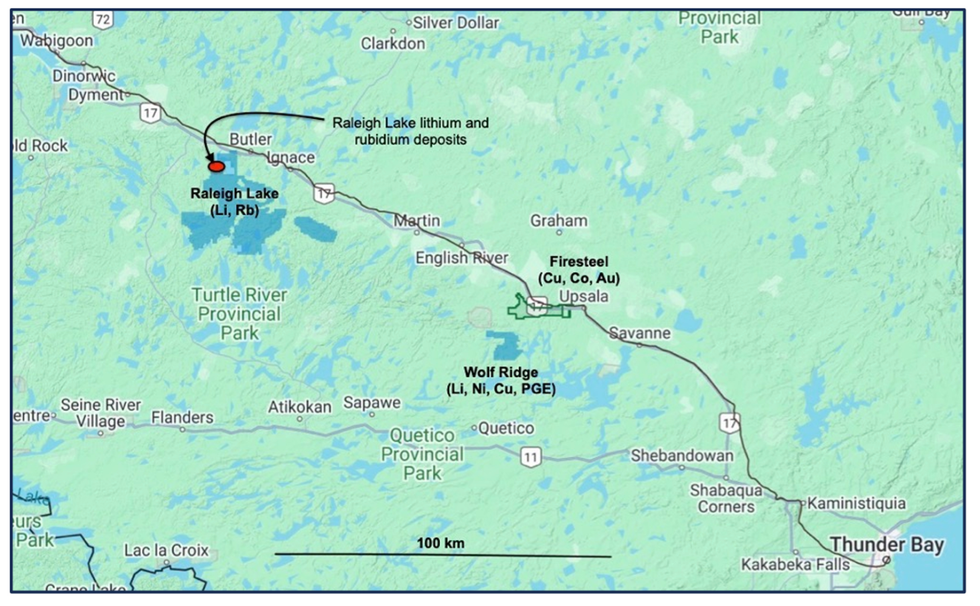
International Lithium's flagship asset is the 100 percent owned Raleigh Lake lithium and rubidium project in Ontario. A preliminary economic assessment (PEA) for the Raleigh Lake project, completed in December 2023, demonstrated strong project economics and significant resource growth potential, including an annual after-tax cash flow of C$634 million, NPV of C$342.9 million and IRR of 44.3 percent, with a nine-year mine life and project duration of 11 years. This assessment did not yet include rubidium, which represents significant additional potential pending further market analysis.
Complementing its lithium focus, the company is advancing the Firesteel copper-cobalt project in northwestern Ontario, targeting high-grade base metal mineralization to further diversify its critical metals exposure.
In addition to its Canadian projects, International Lithium is positioning for further international growth with a strategic focus on Southern Africa. It has applied for exclusive prospecting orders (EPOs) in Zimbabwe, one of the world's most prospective regions for hard rock lithium exploration.
Recent strategic divestments, including the sale of the Avalonia project stake, have strengthened ILC's financial position, enabling focused investment in its core projects.
The company is led by an experienced management team with a strong technical background in mineral exploration, project development and corporate finance. Supported by access to established infrastructure, a commitment to sustainable development practices, and a clear strategic focus, International Lithium is well-positioned to capitalize on the increasing global demand for lithium and other essential materials critical to the clean energy transition.
Company Highlights
- International Lithium is focused on developing lithium and critical metals projects in Canada and Southern Africa, aiming to deliver shareholder value through project development, strategic partnerships and project sales.
- Raleigh Lake is ILC’s wholly owned flagship lithium-rubidium project in Ontario, Canada, with a positive PEA completed in December 2023.
- ILC holds a 90 percent interest in the Firesteel copper and cobalt project in Northwestern Ontario, with exploration permits filed and drilling programs planned.
- The company has applied for exclusive prospecting orders (EPOs) in Zimbabwe and is continuing to review further exploration opportunities in Southern Africa.
- ILC is debt-free with a robust financial position. It has monetized its non-core assets, including the sale of its stake in the Avalonia project in Ireland, resulting in a C$2.5 million payment and a 2 percent net smelter royalty.
- The company is led by an experienced management team with a proven track record in advancing mineral exploration projects.
Key Projects
Raleigh Lake
The Raleigh Lake project is ILC’s flagship asset, located approximately 25 kilometres west of Ignace, Ontario. The project covers a contiguous land package of 32,900 hectares and is 100 percent owned by the company. Raleigh Lake benefits from excellent infrastructure access, situated near the Trans-Canada Highway, a Canadian Pacific Railway line, and existing natural gas and hydroelectric infrastructure.
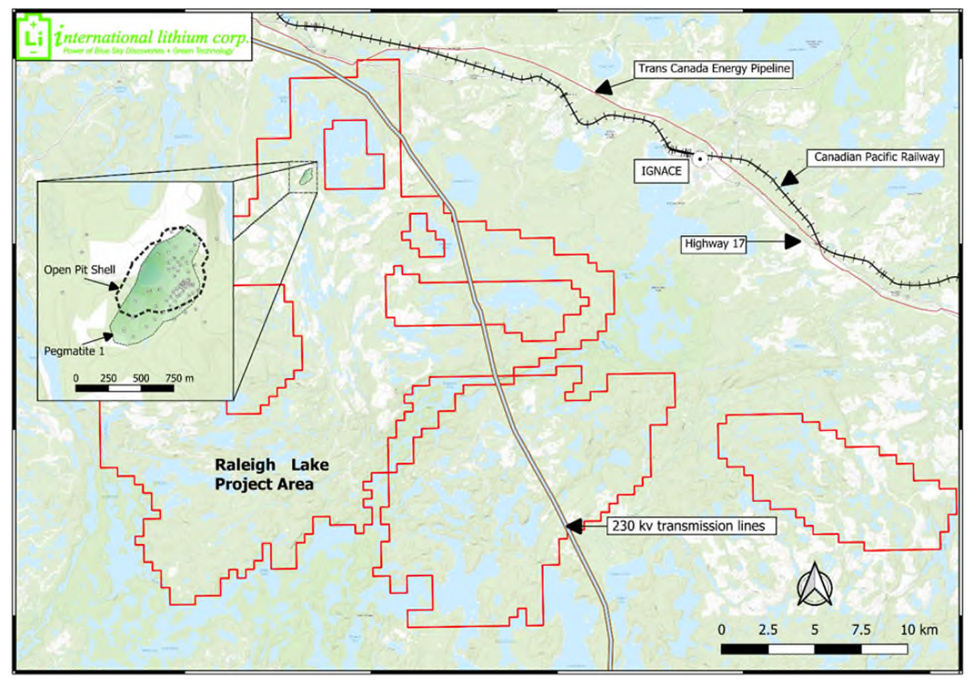
Major public infrastructure relative to the Raleigh Lake project
Raleigh Lake is notable for its dual potential to host both lithium and rubidium mineralization. The lithium is found primarily in spodumene-bearing pegmatites, while rubidium is associated with microcline-rich zones of the same lithium-cesium-tantalum pegmatite system. In 2023, International Lithium published a maiden mineral resource estimate (MRE) that delineated significant resources for both lithium and rubidium using separate cutoff criteria.
For lithium (Li₂O), the project hosts a measured and indicated resource of 5.88 Mt grading 0.79 percent Li₂O, and an inferred resource of 2.07 Mt grading 0.77 percent Li₂O, primarily within pegmatite #1. This lithium resource forms the basis of the company’s PEA, which demonstrated robust project economics with an after-tax NPV (8 percent) of C$342.9 million and an IRR of 44.3 percent.
The rubidium component, though not included in the PEA due to current market constraints, represents an additional potential value stream. The company has reported a measured and indicated resource of 133,000 tons at 6,163 ppm rubidium (0.67 percent Rb₂O) and an inferred resource of 123,000 tons at 4,224 ppm rubidium (0.46 percent Rb₂O), using a 4,000 ppm cutoff. The rubidium zones are found in association with potassic feldspar, offering a potentially recoverable byproduct pending further market and technical evaluation.
Given the project’s strong infrastructure position, mineral endowment, and defined development path, Raleigh Lake represents a compelling advanced-stage opportunity in North America's lithium supply chain. International Lithium is continuing infill and expansion drilling, environmental baseline studies, and metallurgical testing to support project advancement toward pre-feasibility.
Firesteel Project
The Firesteel project is an early-stage copper-cobalt exploration property located in northwestern Ontario, approximately 10 km west of Upsala along Highway 17. Spanning a 16-km corridor to the Firesteel River, the property lies within a geologically favorable region characterized by Archean metavolcanic and metasedimentary rocks, which are prospective for volcanogenic massive sulphide (VMS) and sedimentary copper systems.
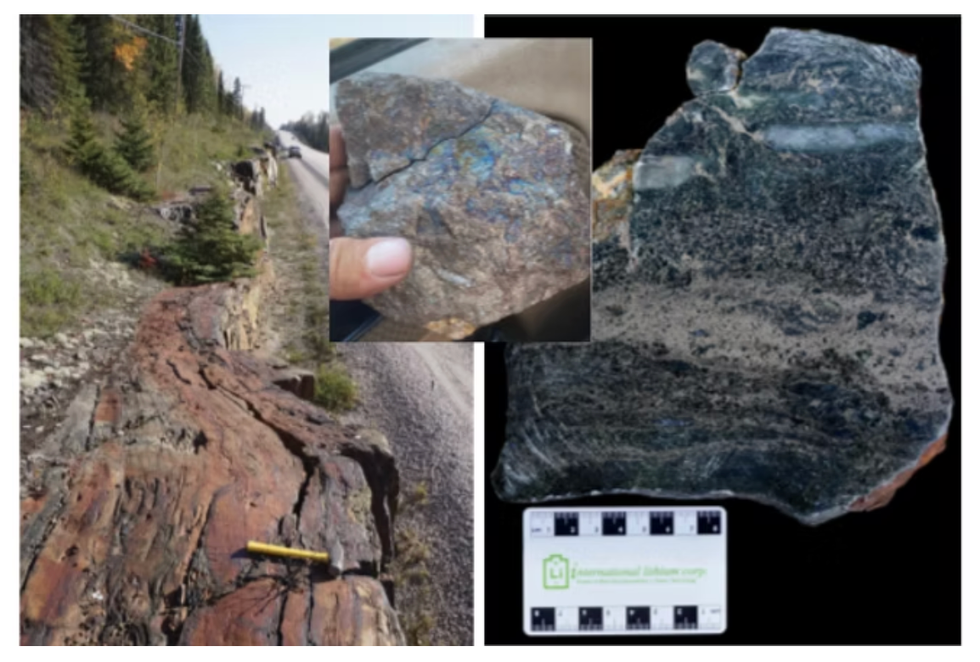
International Lithium completed the acquisition of a 90 percent interest in the Firesteel project in May 2024, aiming to diversify its critical metals portfolio beyond lithium. Historical sampling on the property has returned encouraging results, including copper assays up to 2.6 percent and cobalt values reaching 309 ppm. Notably, the "Roadside 1" occurrence features semi-massive sulphide mineralization comprising pyrite, pyrrhotite, chalcopyrite and bornite. These findings suggest the presence of a highly metamorphosed VMS or sedimentary copper system, potentially up to 20 meters wide and extending over a kilometer in length.
The project's proximity to major infrastructure, including highways and railways, coupled with its strategic location near the company's Raleigh Lake project, enhances its development potential. International Lithium plans to conduct systematic exploration, including geochemical sampling and geophysical surveys, to refine targets for future drilling campaigns.
Wolf Ridge Project
Wolf Ridge is a 5,700-hectare grassroots lithium project located 20 km southwest of Upsala and near ILC’s Firesteel copper claims. The area benefits from excellent infrastructure, including proximity to Highway 17, power, and road access.
The project was highlighted by the Ontario Geological Survey (2021–2022) for its standout lake sediment anomalies - among the highest lithium values in the region - indicating strong potential for LCT pegmatite mineralization.
Read more on page 54 of the report here.
Southern Africa Exploration Initiative
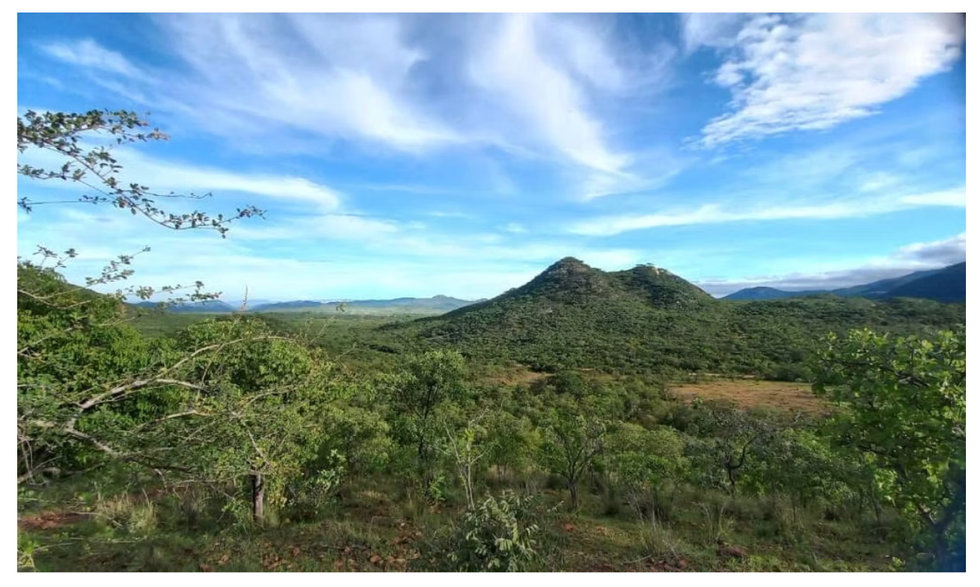
Southern Africa is recognized as a prospective region for hard rock lithium, and International Lithium’s strategic focus reflects a proactive move to establish a presence in this emerging jurisdiction.
As part of its strategy to expand its critical metals footprint, International Lithium has applied for Exclusive Prospecting Orders (EPOs) over several prospective areas in Zimbabwe. The targeted regions are known for hosting spodumene, lepidolite and petalite-bearing pegmatites, indicating potential for significant lithium resources.
Although the EPO applications are still pending approval, the company has already conducted initial due diligence, including geological reviews and desktop studies, to prioritize exploration targets once access is granted. Zimbabwe’s growing importance as a global lithium supplier, combined with favorable mining policies, offers a compelling backdrop for the company's expansion efforts. International Lithium intends to leverage its technical expertise and exploration experience to quickly evaluate and develop these opportunities upon receiving the necessary permits
Management Team
John Wisbey – Chairman and CEO
John Wisbey joined International Lithium in 2017, initially serving as deputy chairman before being appointed chairman and CEO in March 2018. Under his leadership, the company has undergone a significant transformation, including achieving 100 percent ownership of the Raleigh Lake project, divesting non-core assets, and expanding into new jurisdictions such as Zimbabwe. He founded two London AIM-listed companies: IDOX, which provides software for the UK local government; and Lombard Risk Management, which specializes in software for bank risk management and regulation. He also established CONVENDIA, a private company that specializes in software for cash flow forecasting, project valuation and M&A financial analysis. With a background in banking and financial technology entrepreneurship, Wisbey brings extensive experience in corporate leadership and strategic development. He is also the company's largest shareholder.
Maurice Brooks – Director and CFO
Maurice Brooks joined the board of ILC in 2017. He is a licensed senior statutory auditor in the UK. Since 2000, he has been a senior partner at Johnson Smith & Co. in Staines, Surrey. Before that, Brooks was a senior partner in Johnsons Chartered Accountants in the London Borough of Ealing. His commercial and investment experience includes executive directorships in manufacturing and an investment accountant role in the superannuation fund of the Western Australian state government. His early professional employment includes Ball Baker Leake LLP and LLC and Price Waterhouse Coopers-UK.
Anthony Kovacs – Director and COO
Anthony Kovacs joined the board of ILC in 2018 and has worked with the company since 2012. He has over 25 years of experience in mineral exploration and development. Before joining ILC, he held senior management roles in which he sourced and advanced iron ore and industrial minerals projects. Kovacs was involved in early-stage work at the Lac Otelnuk Iron Ore project in Quebec, Canada and the Mustavaara Vanadium Mine in Finland. Before that, Kovacs worked for Anglo American where he focused on Ni-Cu-PGE and IOCG projects. At Anglo-American, Kovacs was directly involved in several discoveries internationally. Kovacs has significant experience with industrial minerals, ferrous metals, non-ferrous metals and precious metals projects throughout the Americas, Europe and Africa.
Ross Thompson – Non-executive Director
Ross Thompson joined the board of ILC in 2017 and is the chair of the audit and remuneration committees. He is a speaker and expert in marketing behavioral science. In 1995, he founded Giftpoint Ltd. which is now one of the largest specialist promotional merchandise businesses in the UK. with offices in London and Shanghai. Giftpoint Ltd.’s clients include L’Oreal, Oracle, Ocado and Pernod Ricard among others. Thompson was president of IGC Global Promotions, one of the world’s oldest and largest global networks of premium resellers, for seven years. He is an active investor with a special interest and understanding of natural resources businesses.
Geoffrey Baker – Non-executive Director
Geoff Baker joined the board of ILC at the end of 2022 and is a member of the audit committee. He has a career in the natural resource and finance industries. He is a director of Tim Trading, a company offering consultancy services in the oil and gas industry. During his tenure as manager of Insch Black Gold Funds, Baker received the Investors' Choice Swiss Fund Manager of the Year Award. He is a co-founder of a digital collectible non fungible token CryptoChronic and of Cannastore, a pilot e-commerce website. Baker holds a bachelor's degree from the University of Windsor in Ontario.
Muhammad Memon – Corporate Secretary and Financial Controller
Muhammad Memon became corporate secretary of ILC in 2021. He has over 10 years of experience in managing finance and compliance functions of public companies in various sectors including mining exploration, investment management, real estate and technology. He assists companies with debt and equity financings, cash flow management and forecasting, legal and regulatory compliance, investor communications, stakeholder engagement and risk management. He is a member of the Chartered Professional Accountants of Canada and a fellow of the Association of Chartered Certified Accountants, United Kingdom.
Keep reading...Show less
02 July
3 Key Themes from Fastmarkets' 2025 Lithium Supply & Battery Raw Materials Event
Market volatility, Chinese control, supply chain risk mitigation and financing emerged as some of the most prevalent themes at the 2025 Fastmarket’s Lithium Supply Battery Raw Materials (LBRM) conference in Las Vegas.
The event, which is in its 17th year, drew a crowd of roughly 1000 delegates, industry experts and analysts, to discuss the current landscape and future projections of the battery materials sector.
During his opening remarks, Fastmarkets CEO Raju Daswani highlighted the growth and maturation the battery raw materials sector has experienced.
“We meet here at an extraordinary moment, the global lithium and battery materials industry is no longer a niche … It is now central to energy security, to industrial policy and to geopolitical strategy,” he said.
INN is live from Las Vegas at @Fastmarkets' Lithium Supply & Battery Raw Materials Conference!
— Resource Investing (@INN_Resource) June 25, 2025
This year's event features 1,000 attendees and 543 companies. Stay tuned for our coverage.#Lithium #BatteryMetals pic.twitter.com/yvh7CPVJm1
Daswani then went on to set the tone for the conference by posing four key questions about the current market designed to guide attendees' thinking throughout the event.
- Decoupling vs. Interdependence: Can the US and China truly decouple their lithium and battery supply chains, or will market realities force continued interdependence?
- Technology Leadership Race: Who will lead battery innovation?
- Price Sustainability: How sustainable is the current lithium price environment?
- Hidden Supply Chain Risks: What proactive steps can the industry take to address emerging risks like permitting delays, power constraints, community opposition, water limitations, talent shortages, and geopolitical instability in critical mining regions?
These questions framed the agenda for the four day event while also underscoring some of the key challenges and strategic considerations facing the global lithium and battery raw materials industry.
Robust growth projections
China’s dominance in the battery metals space was a central theme at the conference and explored via a variety of angels including supply and demand dynamics, growth projections and collaboration.
At the “Lithium Market Outlook 2025–2035: Navigating Demand Across EVs, Storage, and Strategic Sectors” presentation, Paul Lusty, head of battery raw materials at Fastmarkets painted a bullish picture for the future of lithium prices, despite the current challenges the market is facing.
#EV paradox? Paul Lusty of @Fastmarkets explains that EV sales are slower than expected, but still remain robust on a year-on-year basis.#Investing #ElectricVehicles #BatteryMetals pic.twitter.com/a2REfTQz86
— Resource Investing (@INN_Resource) June 25, 2025
We're facing headwinds, no doubt, and we're also seeing quite a lot of negative or bearish sentiment widespread in the market, and I think at times, it's amplified by voices that really overlooked the phenomenal levels of demand that we're seeing in many aspects of the market,” he said.
Although prices have floundered since 2022, the Fastmarkets team is projecting a 12 percent CAGR through to 2035.
“The long term outcome looks incredibly bullish and very compelling, the fundamentals are really still very strong, and these are anchored in some very powerful, mega trends that we see developing within the global economy.”
These trends include the urgent drive for climate change mitigation, the once in a generational shift in the global energy system, and the rise of energy intensive technologies such as artificial intelligence.
China's place in western supply
As Daswani noted in his opening remarks China’s role in the battery metal sector was a recurring topic at the conference, with several speakers and panelists weighing in.
In one of the most compelling panels “Decoding the China Playbook", panelists recounted the country’s nearly two decade long strategy to develop a robust, vertically integrated supply chain.
Iggy Tan, chairman of Lithium Universe (ASX:LU7,OTCPink:LUVSF), told the crowd China’s dominance in the battery metals sector began with a national goal of lowering vehicle emissions in the cities.
“(The) strategy was to reduce pollution in the cities, and that started the battery revolution,” he said of the nation’s switch to electric scooters and cars.
Additionally, the decision was further supported by a long term mandate.
“With the 15 year plan, government regulations, incentives, and investment started to flow according to the plan,” said Tan. “One of the downsides with Western economies is that (the government) changes every four years, whereas in China, the plan is just updated, and you can make long term investments in this area.”
.@globallithium recounts how #China overtook #Japan's #lithium battery production in the early 2000s.
— Resource Investing (@INN_Resource) June 26, 2025
"It's like Survivor — they outplayed, outwitted and outlasted," he said at @Fastmarkets' "Decoding China Playbook" panel. #Investing #Lithium pic.twitter.com/xagbLhBBAC
As Joe Lowry, president of Global Lithium (ASX:GL1,OTCPink:GBLRF) and widely considered "Mr. Lithium", added the battery supply chain in China, was further strengthened in 2003 when then president Hu Jintao selected the battery industry among his 10 Champion Industries.
Over the two decades since the Asian nation has invested heavily up and down the supply chain.
“If it was a TV show, it would be Survivor. China, outplayed, outwitted, and outlasted their competition,” said Lowry.
Financing the future
As with most cyclical commodities once lithium prices began to fall financing and investment also declined. Although the long term demand outlook is poised to benefit from battery sector expansion and energy storage system growth, the current glut in the market has created a challenge for Western companies.
This was reiterated by SC Insights Founder and Managing Director Andy Leyland, who used a colour coded chart to explain the discrepancy.
.@andyleyland1 of @SCInsightsLLC takes the stage at @Fastmarkets to present his #lithium price rainbow chart, highlighting the discrepancy in production relative to the lithium price.#Investing #BatteryMetals pic.twitter.com/UkRVlQqB3q
— Resource Investing (@INN_Resource) June 26, 2025
Leyland noted that at current low lithium prices (around US$7,000 per ton), companies are not making final investment decisions (FIDs) for new lithium projects.
Additionally over the past 12 months, hardly any FIDs have been happening in the industry. This is because at such low price levels, most projects are not financially viable.
Producers are cutting back on capital expenditures and are unable to justify new investments. The low prices make it economically challenging for companies to move forward with new lithium production projects, effectively freezing new developments in the sector.
This sentiment was echoed at the “Unlocking Funding: Bridging the Liquidity Gap and the Battery Market” panel, where YJ Lee, director and co-fund manager at Arcane Capital Advisers offered advice for junior miners.
“There's very little financing available. So the junior miners … have to really cut the corporate costs, keep that as low as possible. But the operations must go on. They must continue drilling. They must continue developing. Because the next up cycle, I believe, is just around the corner.”
Don’t forget to follow us @INN_Resource for real-time updates!
Securities Disclosure: I, Georgia Williams, hold no direct investment interest in any company mentioned in this article.
Keep reading...Show less
02 July
Metals Australia
Investor Insight
Metals Australia offers investors exposure to a rapidly advancing, high-grade graphite development project in Quebec with near-term growth catalysts, backed by strong government support, battery-grade test results, and a diversified portfolio of critical, precious and base minerals assets in tier-1 jurisdictions.
Overview
Metals Australia (ASX:MLS) is a mineral exploration company with a high-quality portfolio of advanced battery minerals and metals projects in tier-1 mining jurisdictions of Western Australia and Canada. The portfolio comprises two critical minerals projects in Quebec, Canada – the Lac Carheil flake graphite project and the Corvette River gold, silver and base metals project. The Australian portfolio comprises two projects: Warrego East (copper-gold) in Tennant Creek, Northern Territory, and Manindi (vanadium-titanium, zinc) in Western Australia.
The push for net zero targets and the call from policymakers to transition to cleaner energy has intensified the focus on electric vehicles (EVs) and battery storage. EV automakers and battery manufacturers rely on essential materials such as graphite and metals, including lithium, nickel, copper and cobalt, to manufacture the batteries that are used in these vehicles and storage batteries generally. This has driven carmakers and battery manufacturers to partner with battery material suppliers under direct off-take agreements. Further, some automakers/battery manufacturers are buying equity stakes in miners, involving them directly in financing decisions for the development of mining projects. This is encouraging for companies such as Metals Australia as it actively advances its projects towards development.

Graphite is a critical mineral required for the mass electrification of auto transportation.
Metals Australia is focused on progressing its flagship Lac Carheil flake graphite project in Quebec, Canada. The project is well-positioned to supply high quality graphite products, including battery-grade graphite, to the North American market – including for lithium-ion and EV battery production in the future. The company has completed a major winter drill program and is targeting a mineral resource upgrade in Q3 2025, with the updated resource to feed into the ongoing PFS and downstream studies.
Metallurgical work has demonstrated battery-grade spherical graphite (99.96 percent graphitic carbon) with high conversion efficiency and tap density. Downstream battery-grade purification and shaping test work is underway in Germany with ANZAPLAN.
Metals Australia is also advancing its gold silver and base metals exploration project at Corvette River, which is adjacent to Patriot Battery Metals’ world-class lithium project. Work to date has included mapping, trenching and sampling, with further drilling programs planned for 2025.
The company continues its exploration programs at its other Australian projects: Manindi (vanadium-titanium-magnetite) and Warrego East (copper-gold).
Company Highlights
- Metals Australia is rapidly advancing its flagship Lac Carheil graphite project in Quebec, Canada.
- The company holds a high-quality suite of exploration projects, including:
- gold, silver and base metals in Quebec
- vanadium, titanium and magnetite (VTM) in Western Australia (WA) – beside an already declared zinc-copper and silver mineral resource and copper-gold in the Northern Territory (NT)
- All projects are located in tier-1 mining jurisdictions (Canada and Australia) with world-class prospectivity and stable geopolitics.
- The company’s four key projects include: Lac Carheil (graphite); Corvette River (gold, silver and base metals); Manindi (vanadium-titanium-iron + zinc-copper-silver) in WA; Warrego East in the NT (copper-gold)
- A 9,482 meters winter drilling program was completed at Lac Carheil in early 2025, increasing total drilling to ~11,800 meters.
- The program added more than 4,000 m of graphitic carbon drill intercepts to the 840 m used to define the initial mineral resource.
- Graphite mineralisation has now been confirmed to be over 2.3 km of strike length, up from 1 km, on just one of 10 mapped trends.
- A mineral resource estimate (MRE) update is expected in Q3 2025 to expand the existing JORC 2012 mineral resource of 13.3 Mt @ 11.5 percent Cg, and to support an expanded mine plan.
- Only 6 percent of 36 km mapped graphite trends have been drilled to date.
- Battery-grade graphite testing confirmed:
- 99.96 percent Cg purity
- 65.3 percent battery anode conversion efficiency
- 0.97 kg/L tap density
- A pre-feasibility study (PFS) is progressing with Lycopodium, and ANZAPLAN is advancing downstream test work for a battery anode material (BAM) facility.
- A C$600,000 grant awarded to Lac Carheil from the Quebec government to support pilot metallurgy and downstream studies.
- Exploration also continues across the Corvette River, Manindi, Warrego East Projects.
- Metals Australia is led by a seasoned board and management team with extensive mining experience and a strong track record of project development.
Key Projects
Canada
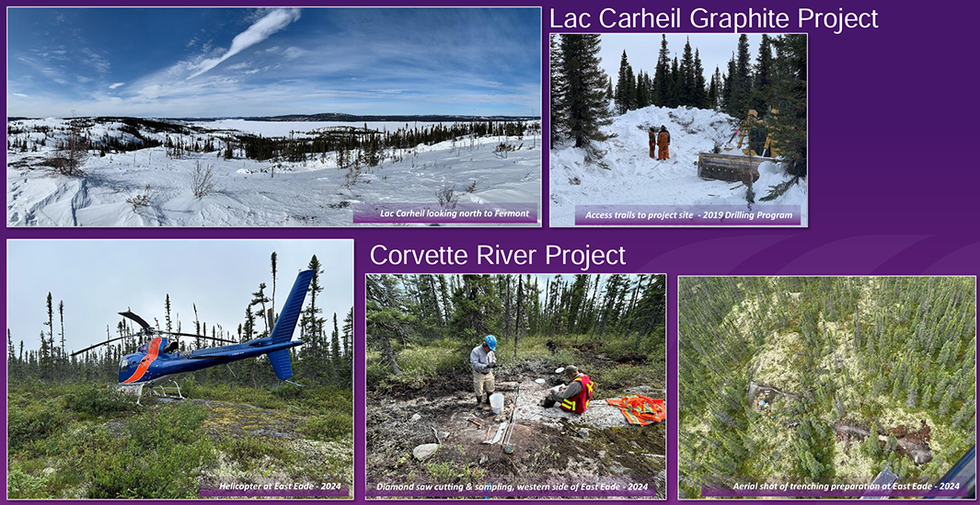
Lac Carheil Flake Graphite Project (MLS 100 percent)
The 100 percent owned Lac Carheil graphite project is located in eastern Quebec, a tier-1 mining jurisdiction with strong infrastructure and government support. The project lies near the town of Fermont and has excellent access to power and logistics, including proximity to the upgraded Highway 389, nearby hydropower infrastructure, and an expanding provincial road network.
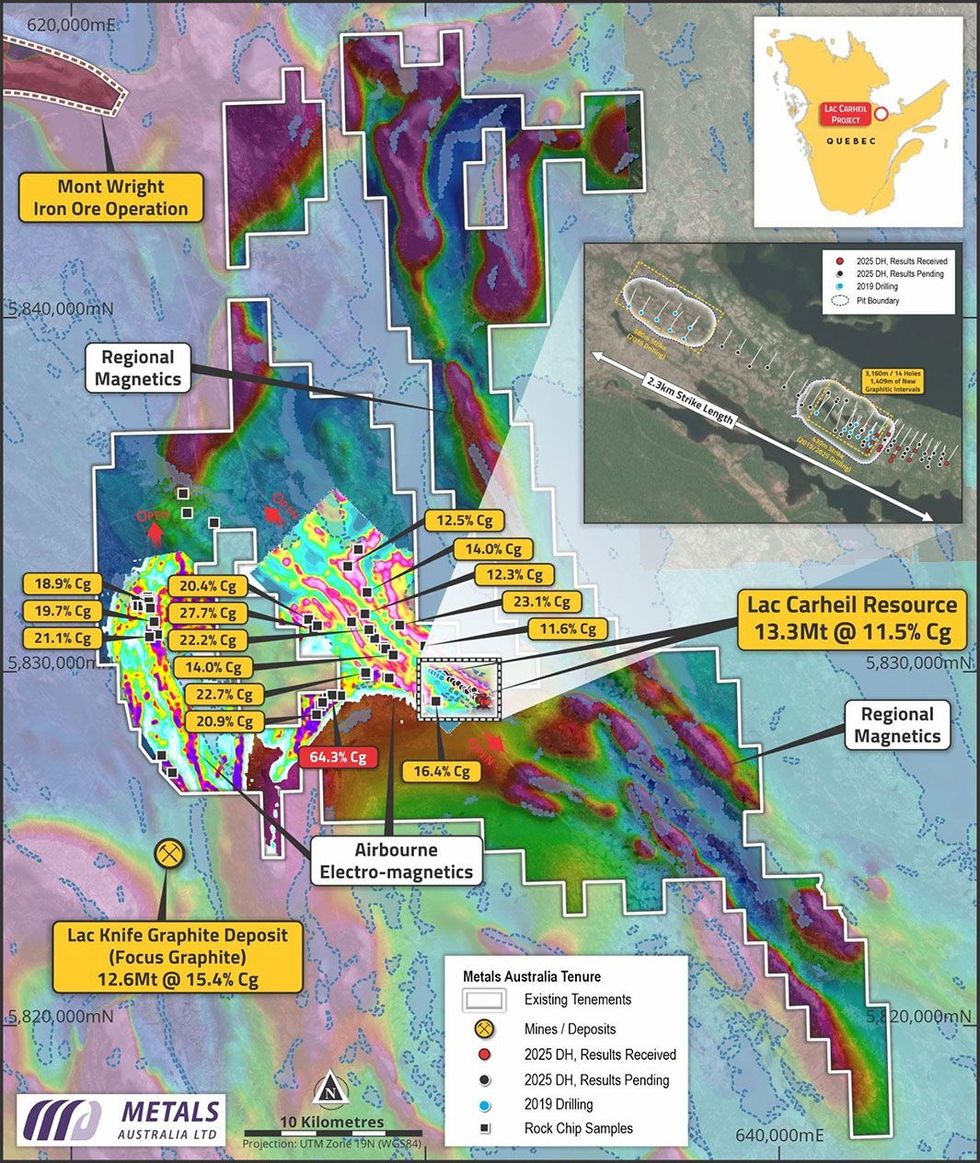
Project location, claims boundaries, graphite resource & trends, regional magnetics & sample results
The current JORC 2012 mineral resource is 13.3 Mt 11.5 percent total graphitic carbon (Cg) for 1.53 Mt of contained graphite, based on limited drilling along just 1 km of a much larger 36 km mapped trend. The resource includes an indicated resource of 9.6 Mt @ 13.1 percent Cg, and inferred resource: 3.7 Mt @ 7.3 percent Cg.
A major 9,482-meter winter diamond drilling program was completed in early 2025, increasing total project drilling to ~11,800 meters. The program defined a new southeast extension zone with multiple intersections >15 percent Cg and demonstrated graphite continuity over 2.3 km of strike length, more than double the previous extent.
The results from this drilling campaign are being incorporated into an updated mineral resource estimate, expected in Q3 2025, which will underpin the next stage of project development.
Metallurgical and battery test work has confirmed Lac Carheil’s graphite is suitable for battery-grade applications, with:
- Flotation concentrate purity of 97 percent Cg
- Spherical graphite purity of 99.96 percent Cg
- Tap density of 0.97 kg/L
- Anode conversion efficiency of 65.3 percent, exceeding global industry averages
A PFS is being led by Lycopodium Minerals Canada and is progressing in parallel with downstream battery anode (BAM) test work led by ANZAPLAN in Germany, a location study for a BAM facility, likely in Canada, and marketing and pricing assessments in collaboration with Lone Star Technical Minerals.
The project is uniquely positioned to meet North America’s surging demand for secure, domestic graphite supply, especially for EV and energy storage battery markets. It represents a strategic, high-grade, long-life source of critical material, with potential for vertical integration from mine to battery anode material.
Corvette River Gold, Silver and Base Metals Project (MLS 100 percent)
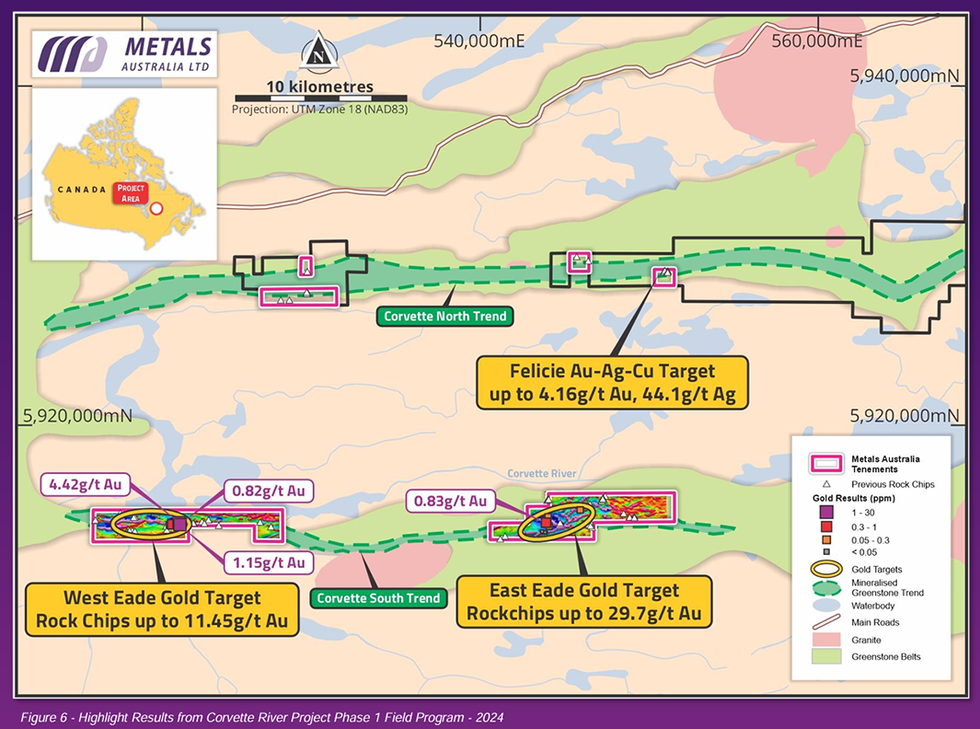
Highlights of results from Corvette River project phase 1 2024 field program
The Corvette River gold, silver and base metals project is located in Quebec’s James Bay region. Corvette River comprises multiple prospects including East Eade, West Eade and Felicie. The 2024 program confirmed high-grade gold and base metal zones, with trench samples of up to 29.7 g/t gold. Field programs are ongoing, with follow-up work planned in 2025.
Australian Projects
Manindi Project (MLS 80 percent)
Located in the Murchison District of Western Australia, the Manindi project includes a JORC-compliant zinc-copper-silver resource of 1.08 Mt at 6.52 percent zinc, 0.26 percent copper and 3.19 g/t silver. The project also hosts a high-grade vanadium-titanium-iron (Ti-V-Fe) discovery zone situated adjacent to the base metals resource.
Recent metallurgical test work from the Ti-V-Fe zone has produced two commercially attractive concentrates: a high-grade iron-vanadium product grading 66 percent Fe and 1.19 percent V₂O₅, and a titanium-iron product grading 43.8 percent TiO₂ and 32.0 percent Fe. The combined mass recovery from the two products exceeded 65 percent of the sample, and both products displayed low impurity levels and strong commercial potential. Further processing optimization is underway to enhance the TiO₂ grade.
The mineralised Ti-V-Fe zone remains open at depth and along strike and is hosted within a 2 km-long magnetic gabbro trend. A program of work is being finalised to support drilling to define a mineral resource within the original discovery and to test four newly identified nearby targets. These complements renewed interest in the zinc-copper-silver resource due to stronger base metal prices.
Warrego East Project (MLS 80 percent)
The Warrego East copper-gold project is located in the Tennant Creek region of the Northern Territory, near the historically significant Warrego Mine. The exploration license (E32725) is fully granted, and the mining management plan has been approved. Land access agreements have also been finalised.
Geophysical surveys have defined 11 compelling magnetic and gravity targets along a known mineralised corridor. These targets lie within a prospective structural setting that hosts several high-grade historical deposits. A field program is being prepared for execution following the wet season, alongside three additional tenement applications that aim to expand the project footprint.
Management Team
Paul Ferguson – Chief Executive Officer
A mining engineer, Paul Ferguson has over three decades of experience in the resources and energy sectors across North America, Asia and Australia. He has extensive project development and operational experience working in Canada. He has worked in oil & gas major ExxonMobil across project stages, including feasibility, design, construction, and operation. He has worked in executive level roles within Australia, including at GMA Garnet and held increasingly more senior roles with BHP (Iron Ore & Coking Coal) and then with Exxon Coal Minerals and Mobil Oil Australia during the early stages of his career.
Tanya Newby – CFO and Joint Company Secretary
Tanya Newby is a finance and governance professional with over 20 years’ experience in various corporate and commercial roles. She has a strong background in the resources sector and has provided financial advice and assistance to several publicly listed entities through exploration, project development through to the production stage. She is a member of the Institute of Chartered Accountants, member of the Governance Institute of Australia and a graduate member of the Institute of Company Directors.
Michael Muhling – Joint Company Secretary
Michael Muhling has over two decades of experience in resources, including 15 years in senior roles with ASX-listed companies. He is a fellow of CPA Australia, The Chartered Governance Institute, and the Governance Institute of Australia.
Chris Ramsay – General Manager Geology
Chris Ramsay is a geologist and project manager with over 25 years of experience in the global mining industry. He has been involved in exploration, mine development and operations for mining projects in Australasia, Southeast Asia, and parts of Africa and North America.
Board
Michael Scivolo – Non-executive Chairman
Michael Scivolo has extensive accounting and taxation experience for corporate and non-corporate entities. He was a partner/director at a CPA firm until 2011 and has since been consulting in accounting and taxation. Scivolo is on the boards of several ASX-listed mining companies, including Sabre Resources, Golden Deeps and Tennant Minerals Ltd.
Alexander Biggs – Non-executive Director
Alexander Biggs has over 20 years of experience in the mining and engineering sectors. During his career, he has been involved in various activities, including operations, consulting, finance and capital raising. He is currently the managing director of Lightning Minerals (ASX) and was previously the managing director of Critical Resources (ASX: CRR). Biggs is a member of the Australian Institute of Mining and Metallurgy and a graduate of the Western Australian School of Mines.
Rachelle Domansky – Non-executive Director
Rachelle Domansky is an ESG specialist and a consulting psychologist for businesses, governments and educational institutions in the Asia-Pacific region. In addition to Metals Australia, Domansky holds non-executive board positions at Larvotto Resources Ltd and Quebec Lithium.
Basil Conti – Non-executive Director
Basil Conti has been associated with the mining industry for over 25 years. He is a fellow of the Institute of Chartered Accountants Australia & NZ and was a partner/director of a chartered accounting firm in West Perth until 2015.
Keep reading...Show less
01 July
Expert: African Lithium Key to China's Battery Supply Chain Dominance
With the global shift to electric vehicles (EVs) accelerating, China is cementing its dominance over the lithium supply chain by pouring investment into African mines, creating a new center of gravity for the battery metal.
Speaking at the Lithium Supply Battery Raw Materials conference, Claudia Cook senior analyst at Fastmarkets offered a sweeping assessment of how China is reshaping global lithium flows and why Africa will be crucial in the next decade.
Cook laid out in detail how China’s lithium strategy is evolving. As the world’s largest EV market, China needs a consistent, low-cost supply of lithium — but its domestic production is increasingly insufficient.
“China needs growing feedstock to supply its chemical demand,” Cook explained at Fastmarkets' Lithium Supply & Battery Raw Materials event, “and Africa is of growing importance in fulfilling this gap.”
Between 2025 and 2035, lithium production across Africa is projected to increase by a staggering 127 percent, driven by new mines in Zimbabwe, Mali, Ethiopia and Namibia. Cook highlighted that against that backdrop Africa’s share of global lithium supply will surge from a small fraction today to around 80 percent by 2030.
The motivation for China is clear: the Asian nation cannot meet demand by tapping domestic sources alone. China’s hard-rock lithium supply has a growing deficit that will multiply fivefold by 2035.
“That deficit is growing and is said to be a five times increase from 2020 to 2035,” Cook said, pointing to forecasts of rising chemical demand from Chinese battery producers. As a result, Chinese firms have aggressively invested in African lithium projects, locking up supply in countries with looser regulatory controls and cheaper production costs.
In Zimbabwe and Mali, Chinese ownership of lithium mines is expected to remain significant, even if the share of Chinese-owned production in Africa declines modestly from 79 percent in 2025 to 65 percent by 2035.
“In 2025, African output is set to have 79 percent of it being China owned, and that percentage reduces down to 65 percent in 2035,” Cook stated, adding that overall output will still nearly double.
As a result, total Chinese-controlled volumes will keep rising.
Zimbabwe’s rising role in the lithium sector
Zimbabwe in particular has positioned itself at the heart of Africa’s lithium expansion.
Under its Vision 2030 program, introduced in 2018, the country is aiming to transition to an upper- to middle-income economy by building more domestic value from its minerals. As part of this framework, authorities have prioritized increasing value addition and beneficiation of raw materials as a central pillar of economic growth
Zimbabwe's 2022 ban on raw lithium ore exports, coupled with a planned 2027 ban on concentrate exports, is designed to force local upgrading and refining. Chinese-backed operators have already responded to this move, investing in midstream processing facilities that convert lithium ore into more valuable chemicals.
Cook said there were no surprises in Zimbabwe’s 2027 concentrate ban because Zimbabwe’s largest lithium projects — Arcadia and Bikita — had already planned sulfate plants late last year.
Both projects are already dominated by Chinese investors. In fact, Cook said Zimbabwe could soon become the fifth-largest producer of mined lithium globally, with Chinese interests controlling as much as 90 percent of its output.

Slide from Cook showing Zimbabwe's future lithium supply dominance in Africa.
Image via Georgia Williams.
Despite this surge, Africa’s lithium boom is hardly risk-free. Cook flagged serious challenges in transport, electricity and worker conditions in her presentation at the Fastmarkets conference.
“Local workers often also tend to be within the lower skilled jobs, and unlike the Australian mines, a lot of that work is done manually, which can mean there is an increased risk to personal safety,” she said.
Road bottlenecks and port congestion in countries like South Africa hamper exports, while rolling blackouts push some miners to build their own power infrastructure. However, China’s Belt and Road Initiative is easing some of those pain points, upgrading key transport corridors to keep African lithium flowing.
China pushing to secure lithium supply
Domestically, China is also seeing a shift in how it sources lithium.
Benchmark Mineral Intelligence data shows that brine-based production, once a major source for China, is declining relative to hard rock. By 2035, hard rock will make up the majority of Chinese feedstock.
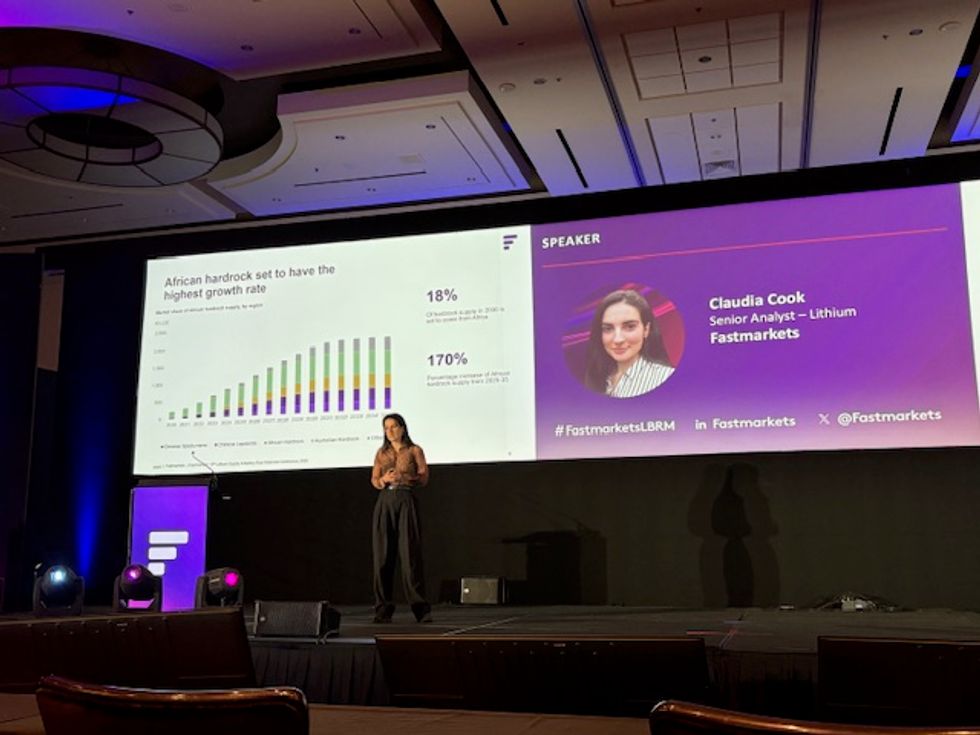
Cook speaks on stage at the Fastmarkets event.
Image via Georgia Williams.
While the reopening of CATL's (SZSE:300750,HKEX:3750) mine in Jiangxi province this year will help, Cook argued that China is still structurally dependent on Africa and other regions to fill the supply gap.
That dependence, she said, is at the heart of Beijing’s long-term lithium security push. “China is directly investing to secure supply, to get that hard-rock feedstock," she commented.
Future regional lithium players in Africa
While Zimbabwe, along with Mali, is grabbing attention now, Cook forecast that new African lithium suppliers will emerge by 2035, including Ethiopia, Namibia and the Democratic Republic of Congo.
She also noted potential future lithium supply growth from Rwanda, Nigeria and Côte d'Ivoire, even though these countries are still years away from commercial production.
This potential dominance could come with price advantages too.
African lithium projects often have lower upfront costs compared to Australia because of their lower grades and cheaper labor, even though they may face higher impurities and weaker ESG oversight.
“It also means that in terms of pricing, we see that the spodumene price that's coming out of some of these projects is typically around US$20 to US$30 lower than the spot price that you'll see quoted by Newcastle,” Cook noted.
Still, quality issues and chronic underinvestment in African infrastructure could slow progress. Cook emphasized that transport, electricity reliability and governance will determine whether Africa can live up to its lithium promise.
Don’t forget to follow us @INN_Resource for real-time updates!
Securities Disclosure: I, Giann Liguid, hold no direct investment interest in any company mentioned in this article.
Keep reading...Show less
26 June
Market Pain, Strategic Gain: Pilbara Minerals' Dale Henderson on Today's Lithium Paradox
“(Lithium) is not for the faint-hearted. It demands resilience, foresight and leadership,” said Pilbara Minerals (ASX:PLS,OTC Pink:PILBF) Managing Director and CEO Dale Henderson.
He was speaking at Fastmarkets’ Lithium Supply & Battery Raw Materials Conference, held this week in Las Vegas.
Henderson touched on three main points: current lithium market dynamics, how Pilbara Minerals is navigating the lithium landscape and his recommendations for the global lithium industry.
Lithium's strong long-term fundamentals
Henderson began by going over key numbers relevant to the lithium sector. According to the CEO, there was a 26 percent year-on-year increase in demand for electric vehicles (EVs) from 2023 to 2024.
Lithium plays a vital role in the production of EVs, as it is a key component of the batteries that power them.
Alongside that EV demand increase, mass energy storage also saw a 51 percent leap.
“I don’t think there’ll be any deniers around the long-term prospects of lithium, but it's worth reflecting on how quickly it’s changing," Henderson told the Fastmarkets audience.
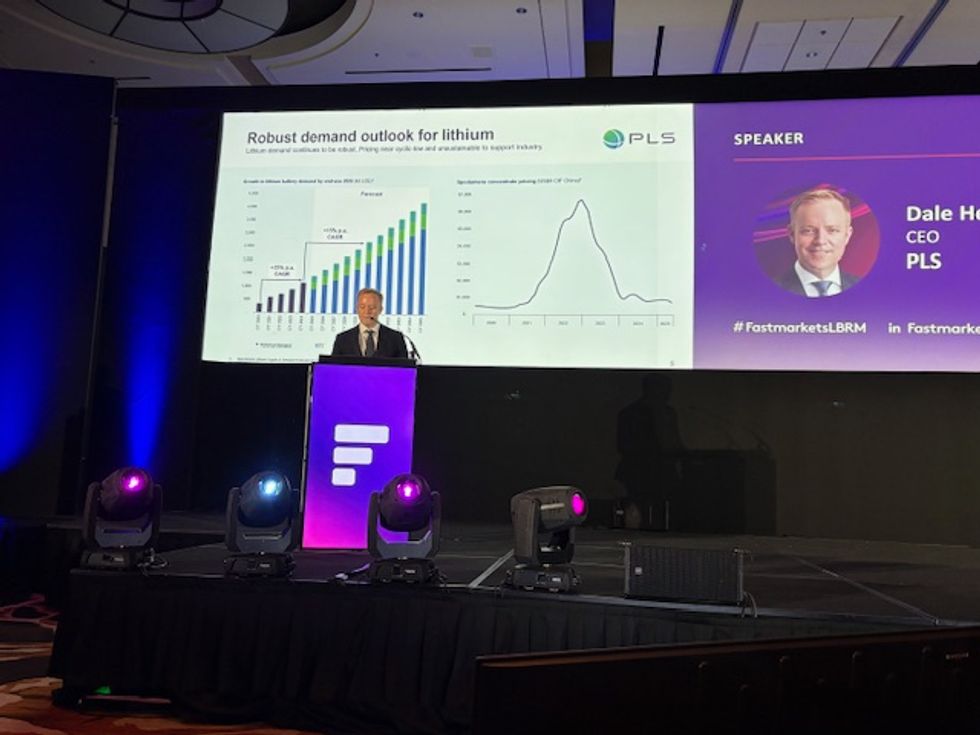
Henderson speaks on stage at the Fastmarkets event.
Image via Georgia Williams.
Looking at areas connected to lithium, Henderson mentioned solar, saying it now surpasses all power-generation technology investment combined. Solar falls under the clean energy umbrella, which receives more than $2.2 trillion in investment per year — twice the amount of investment made in fossil fuels.
“We are witnessing and (are) part of an incredible period. Technology, policy (and) consumer sentiment can continue to drive what is a structural shift towards electrification," he said. "Lithium remains at the center of this shift."
The paradox, according to Henderson, is that while scaling up is happening, prices have been cycling down.
“We’re 12 months into a period of curtailments and reset. And where we are now — we sit deep into the cost curve with price levels, of course, at unsustainable levels for many operators," he noted.
"But these cycles, or these resets, offer a fantastic reset for market, albeit they're painful.”
The Pilbara CEO emphasized that while lithium prices have fallen to “clearly unsustainable” levels, the long-term demand and strategic relevance of lithium will survive it.
“This is not a short-term trend. This is a structural transformation, and lithium remains at core.”
Pilbara Minerals' lithium strategy
Looking over to Pilbara Minerals, Henderson went over its recent achievements and future plans.
“We’re keeping our lives absolutely committed to our strategy,” he said about the company, adding that the past year was Pilbara Minerals' “most transformational year for business.”
Highlights from the period include the acquisition of Latin Resources and its flagship Salinas lithium project in Brazil, which was announced in August 2024 and closed this past February.
The CEO also discussed the company’s flagship Pilgangoora operation, which he described as a globally significant tier-one lithium asset with a mine life of 33 years. Pilgangoora is located 140 kilometers from Port Hedland in Western Australia and is one of the world’s largest hard-rock lithium operations.
Pilbara Minerals has completed two expansions, including the buildout of the world’s largest hard-rock ore-sorting plant, which aims to improve lithium recovery, increase final product quality and reduce energy consumption.
In addition to that, Henderson said Pilbara Minerals boosted its reserves by 23 percent last year.
Furthermore, the company became a lithium hydroxide producer via its partnership with POSCO Holdings (NYSE:PKX,KRX:005490), and is working on a demonstration plant for its midstream project.
In January, the Western Australian government’s Investment Attraction Fund contributed AU$15 million for work at the plant, which is a joint venture with Calix (NYSE:CALX,ASX:CXL).
Henderson said the demonstration plant is currently under construction.
Last year, Pilbara Minerals contributed approximately 8 percent to global lithium supply. The company’s cash balance currently stands at AU$1.1 billion.
Lithium industry must align for success
According to Henderson, certainty and efficient operations are everything in today’s lithium market.
“Government policy is forcing change, both in sticks and carrots, and supply chain diversification is underway, but largely the processing remains very much concentrated," he said.
Henderson highlighted coordination and collaboration as key points, saying that thriving in this environment means building deeper integration across the supply chain.
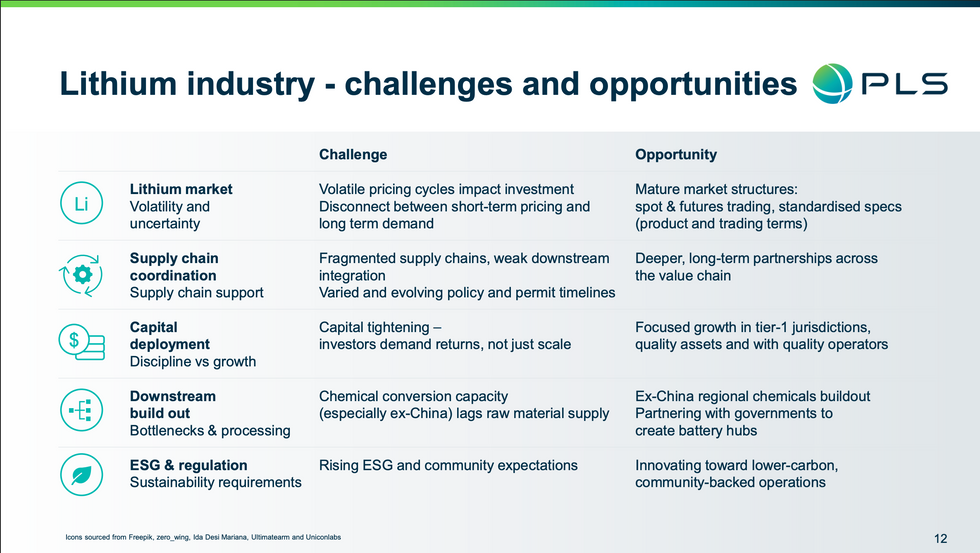
Lithium industry challenges and opportunities.
Chart via Pilbara Minerals.
He added that the lithium industry is not the first sector to grow from a small base and has yet to mature on a number of dimensions. Henderson summarized his key recommendations into four points:
- Support a central and efficient spot market trading location
- Put a trusted futures exchange in place
- Align on specifications across the lithium product site
- Align on standardized trading terms
He also presented a list of challenges and corresponding opportunities regarding the lithium market, saying that while there’s a lot of pain in the industry, it's also the time for great partnerships to be forged.
“This industry will evolve with or without our stewardship. This is a call to leadership across our group,” he concluded. “The challenge is ours. The opportunity is real. Let's build it together and turn this market pain into a strategic avenue.”
Don’t forget to follow us @INN_Resource for real-time news updates!
Securities Disclosure: I, Gabrielle de la Cruz, hold no direct investment interest in any company mentioned in this article.
Keep reading...Show less
Latest Press Releases
Related News
TOP STOCKS
American Battery4.030.24
Aion Therapeutic0.10-0.01
Cybin Corp2.140.00
